You’ll maximize your school’s 3D printer ROI by following seven strategic steps: identify specific educational applications like anatomical models and historical replicas, calculate current outsourcing and traditional manufacturing costs, assign monetary value to reduced teacher prep time (typically saving $300+ per project), analyze material expenses ranging from $20-$100 per kilogram, evaluate long-term STEAM curriculum benefits, assess student skill development for career readiness, and plan scalable growth with industry partnerships. These all-encompassing tactics reveal substantial financial returns and educational advantages.
Identify Educational Applications and Specific Use Cases
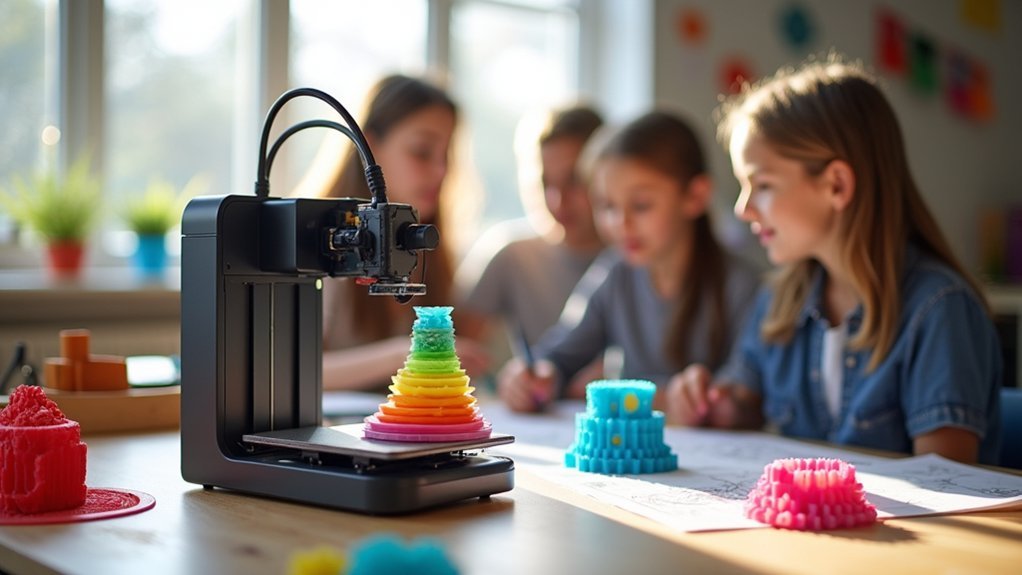
Three primary educational applications demonstrate how 3D printers transform traditional classroom instruction into dynamic, hands-on learning experiences.
You’ll find that creating customized teaching aids like anatomical models for biology or historical replicas for social studies greatly enhances student engagement and comprehension.
3D printing allows students to develop product development skills through rapid prototyping in engineering and design courses, where they’ll iterate designs and solve real-world problems.
Additionally, you can integrate cross-disciplinary collaboration projects that combine art, technology, and engineering principles.
These educational applications prepare students for future careers by providing hands-on experience with design for additive manufacturing while fostering critical thinking skills.
Students gain valuable technical expertise through testing and refining functional prototypes across multiple STEM subjects.
Calculate Current Costs of Alternative Solutions
Understanding the financial benefits of in-house 3D printing requires a thorough analysis of what schools currently spend on alternative manufacturing solutions.
You’ll need to examine outsourcing expenses, including design, production, shipping, and delay costs that often inflate budgets beyond initial estimates. Traditional manufacturing methods like machining or injection molding involve higher labor costs due to skilled operators and extended lead times, reducing your return on investment (ROI).
Calculate material and tooling expenses for conventional processes, which typically exceed 3D printing consumables.
Factor in inventory maintenance costs, as traditional manufacturing requires storing excess parts that tie up capital.
Consider operational efficiency losses from extended project timelines and missed deadlines.
These extensive calculations reveal substantial cost savings potential when shifting to in-house 3D printing solutions.
Assign Monetary Value to Educational Time Savings
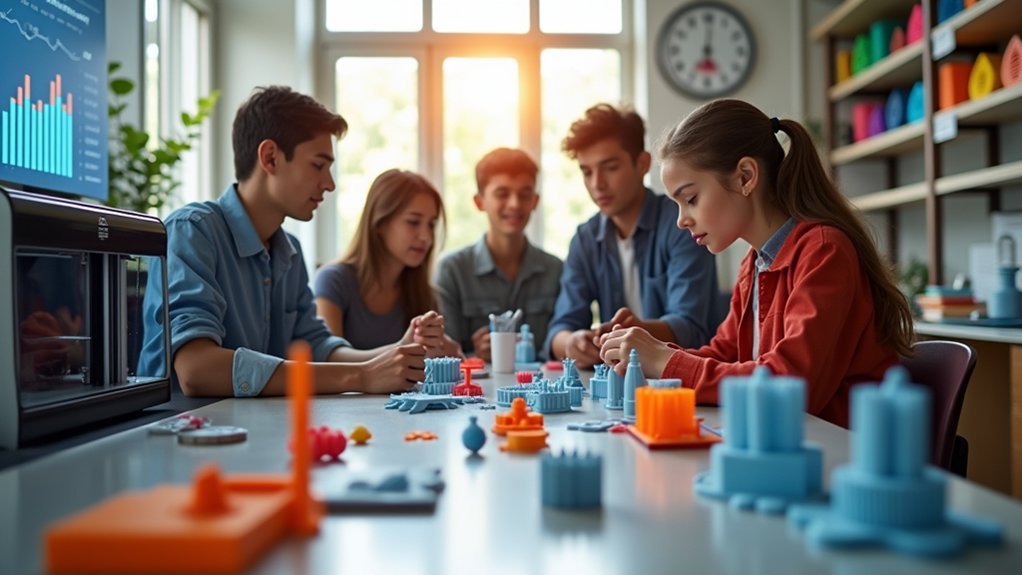
When you calculate the monetary value of educational time savings, you’re quantifying one of 3D printing’s most significant yet often overlooked benefits. Traditional prototyping methods take weeks while 3D printing reduces this to hours, creating substantial cost savings for your institution.
| Method | Time Required | Cost |
|---|---|---|
| Traditional Prototyping | 5 days | $200 |
| 3D Printing | 2 hours | $10 |
| Teacher Prep (Traditional) | 20 hours | $600 |
| Teacher Prep (3D Printing) | 10 hours | $300 |
| Student Iterations | Multiple weeks | High |
Your ROI analysis should include teacher hourly rates multiplied by time saved. If a teacher saves 10 hours per project at $30/hour, that’s $300 in educational time savings. Students complete more design iterations, increasing learning opportunities and project completion rates, making 3D printing investments financially justified.
Analyze Material and Operational Expenses
You’ll need to calculate three critical expense categories when analyzing your school’s 3D printer investment: filament costs per printed part, ongoing maintenance expenses, and energy consumption.
These operational costs directly impact your bottom line, with filament ranging from $20-$100 per kilogram depending on material quality and printer maintenance averaging $500-$1,000 annually.
Your energy bills will also increase since 3D printers consume electricity at $0.10-$0.15 per kWh during those extended print runs.
Filament Cost Per Part
The true cost of each 3D printed part extends far beyond the sticker price of filament.
You’ll need to calculate filament cost per part by weighing your finished prints and multiplying by material costs, which typically range from $20 to $50 per kilogram for PLA and ABS materials.
Don’t overlook operational expenses when analyzing your school’s initial investment returns.
Electricity consumption adds approximately $0.05 to $0.10 per part, depending on your printer’s power rating and print duration.
You’ll also need to factor in maintenance costs for replacing worn components like nozzles and heated beds, which contribute an additional $0.01 to $0.05 per part over time.
Combine these filament and operational expenses to determine your true cost per part, enabling accurate financial forecasting for educational 3D printing projects.
Printer Maintenance Expenses
Beyond filament costs, 3D printer maintenance expenses form a substantial portion of your operational budget that demands careful planning.
You’ll face operational expenses ranging from $50 to $200 annually for replacement parts, depending on your printer’s usage and model.
Consumables like nozzles and build plates add another $100 to $300 to your annual maintenance budget.
Don’t overlook electricity consumption costs, which typically run $100 to $300 yearly based on your printer’s 50-250 watt hourly usage.
The most significant hidden cost involves staff time for routine maintenance—averaging 1-2 hours weekly.
This translates to $500 to $1,000 in labor costs annually, making printer maintenance expenses a critical factor in your ROI calculations.
Energy Consumption Analysis
Understanding your 3D printer’s energy consumption patterns forms the foundation for accurate operational cost projections in your school’s ROI analysis. Desktop FFF printers typically consume 50 to 250 watts during operation, making energy consumption a measurable expense factor.
You’ll calculate your operational cost by multiplying your printer’s wattage by usage hours and your local electricity rate.
Optimize your return on investment (ROI) by implementing efficient printing practices. Minimize idle times and adjust print settings to reduce unnecessary energy usage. These strategies can substantially lower your operational costs while maintaining print quality.
Regular maintenance and proper calibration improve energy efficiency, extending equipment lifespan. By monitoring energy consumption patterns and implementing cost-reduction strategies, you’ll maximize your school’s 3D printing program’s financial sustainability and educational value.
Evaluate Long-Term Curriculum Integration Benefits
You’ll discover that 3D printing creates powerful cross-subject learning opportunities by connecting math concepts through design calculations, science principles through engineering challenges, and artistic expression through creative prototyping.
This integration prepares your students for tomorrow’s workforce by developing the interdisciplinary thinking and technical skills that employers increasingly demand in STEM careers.
Your investment extends beyond equipment costs when you consider how this technology transforms traditional teaching methods into dynamic, hands-on experiences that bridge multiple academic disciplines.
Cross-Subject Learning Opportunities
When you integrate 3D printing across multiple subjects, you’re creating powerful learning connections that traditional teaching methods can’t match. Your printing solution becomes an investment that spans STEM, art, and design curricula, maximizing return through diverse applications.
Students can prototype historical artifacts in social studies, create molecular models in chemistry, and design architectural structures in math class using the same materials and equipment.
Cross-subject projects naturally develop problem-solving skills as students collaborate on real-world challenges. You’ll see enhanced critical thinking when teams engineer solutions that require both technical precision and creative design.
This interdisciplinary approach aligns with STEAM education standards while preparing students for technology-driven careers. The collaborative nature of 3D printing projects builds essential teamwork skills that translate directly into workplace readiness and advanced manufacturing career pathways.
Future Workforce Preparation
Because tomorrow’s workforce demands proficiency in digital fabrication and rapid prototyping, your 3D printing investment directly translates into measurable career preparation advantages for students.
You’ll equip them with essential skills in design, prototyping, and additive manufacturing processes that span multiple industries.
Real-world projects using printing technology enable students to tackle actual business challenges, sharpening their problem-solving abilities and increasing their employment prospects.
When you expose students to advanced manufacturing technology, you’re fostering innovation and creativity that aligns with current industry trends.
Partnerships with local businesses for 3D printing initiatives provide invaluable hands-on experience and networking opportunities.
Your return on investment (ROI) becomes evident through enhanced student engagement, improved retention rates, and graduates who enter the workforce with relevant, practical skills employers actively seek.
Assess Student Skill Development and Career Readiness
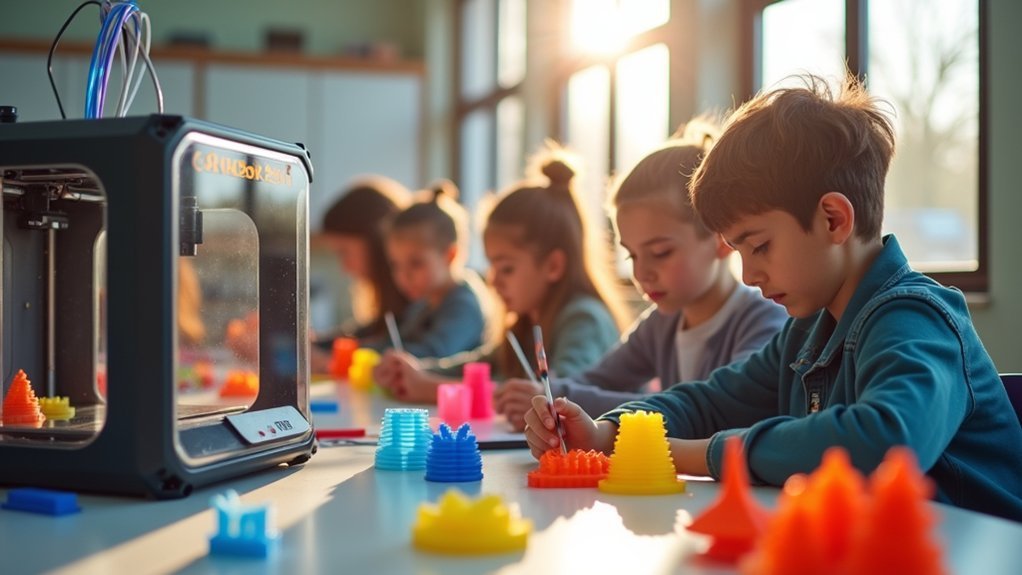
While traditional classroom learning provides foundational knowledge, 3D printing technology transforms how students develop essential career skills through hands-on application.
When you implement student skill development programs using 3D printers, you’re directly enhancing problem-solving and critical thinking abilities through real-world business challenges. Your students gain valuable prototyping experience with Stratasys equipment, fostering innovation and creativity that’s vital for modern manufacturing careers.
Career readiness accelerates when students collaborate with local businesses, developing professional communication and presentation skills. These industry partnerships expose them to authentic business expectations and quality standards.
You’ll notice improved time management as students balance academic work with project deadlines, mirroring professional accountability. Through 3D printing projects, your educational investment yields measurable returns in workforce preparation.
Plan for Scalability and Future Educational Growth
Strategic planning for your school’s 3D printing program expansion starts with anticipating increased student demand and curriculum growth over the next three to five years.
Successful 3D printing program expansion requires forecasting student enrollment trends and curriculum evolution over three to five years.
You’ll maximize your return on investment (ROI) by implementing a phased approach to scalability, evaluating initial success before committing to larger purchases.
Assess your existing infrastructure’s capacity to support additional equipment, including power supply and space requirements.
Partner with industry leaders to access advanced technologies and resources that keep your printing system current with manufacturing practices.
You’ll need to regularly update curriculum to incorporate new 3D printing applications and technologies.
This maintains student engagement while preparing them for future careers in design and manufacturing.
Strategic partnerships can provide cost-effective access to cutting-edge equipment without overwhelming your budget.
Frequently Asked Questions
How to Make Money With a 3D Printer at School?
You can monetize your school’s 3D printer by offering custom printing services to local businesses, hosting community workshops, creating prototypes for startups, and selling educational tools or branded merchandise at events.
What Is the 45 Degree Rule for 3D Printing?
You shouldn’t print overhangs steeper than 45 degrees from vertical without support structures. This rule prevents sagging and print failures, ensuring better quality while reducing material waste and post-processing time.
What Is ROI in 3D Printing?
ROI in 3D printing measures your financial returns compared to initial investment costs. You’ll calculate savings from in-house production, reduced outsourcing expenses, and shorter lead times against equipment, materials, and maintenance costs.
What’s a Good Profit Margin for 3D Printing?
You’ll want to target 30-50% profit margins in 3D printing. Aim for 2-3x markup over direct costs, maintaining 40-60% gross margins to cover overhead and reinvestment while staying competitive.

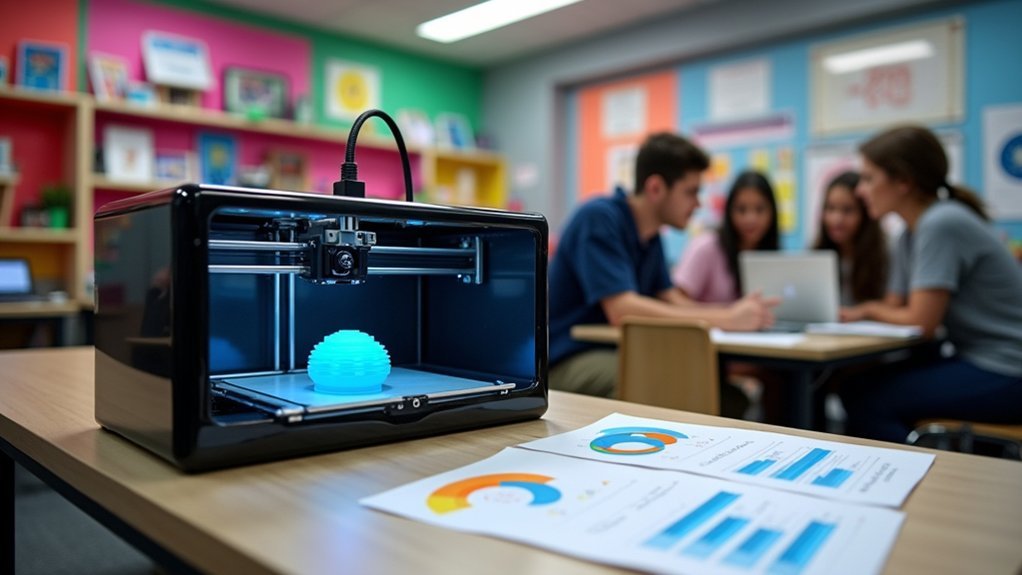


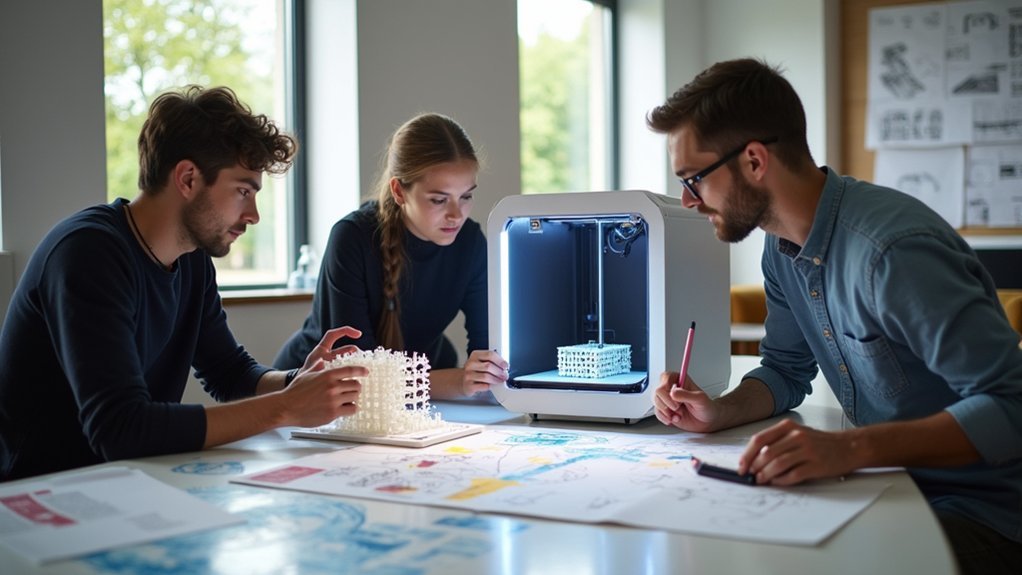
Leave a Reply